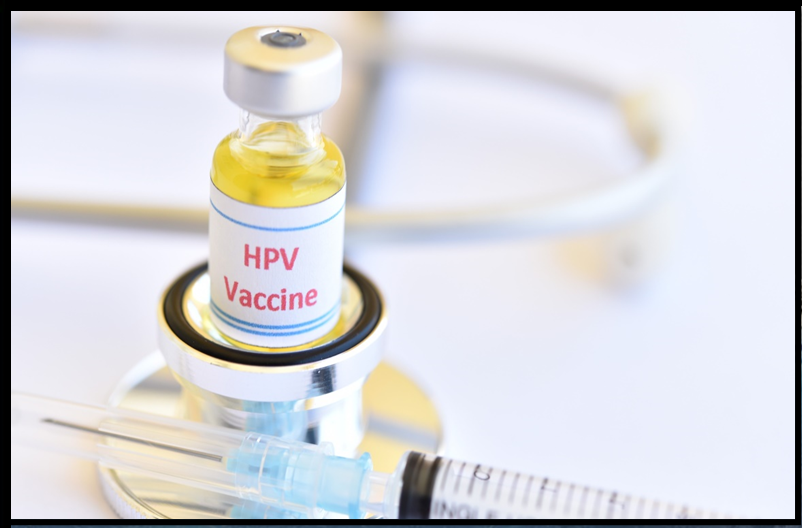A BOLD STEP TOWARDS A CERVICAL CANCER-FREE FUTURE
Syllabus:
GS 3:
- Awareness in the fields of IT, Space, Computers, robotics, nano-technology, bio-technology and issues relating to intellectual property rights.
Focus:
- The push for HPV vaccination for girls, in the 2024-25 interim Budget, marks a new era in women’s health in India.
Source:- IE
Introduction: A Leap Forward in Women’s Healthcare
- Celebration of Women’s Empowerment: Marking International Women’s Day, the interim Union Budget 2024-25 highlights significant strides towards enhancing women’s health.
- Government’s Proactive Approach: The initiative for HPV vaccination for young girls showcases the Modi government’s dedication to improving women’s healthcare.
- Strategic Health Intervention: Targeting girls aged 9 to 14 for HPV vaccination directly addresses a major women’s health issue—cervical cancer.
- Vision for Healthier Future: This initiative is a testament to the government’s vision of a healthier future for women, emphasizing prevention and well-being.
| What is Cervical cancer
· Cervical cancer originates in the cervix and ranks as the fourth most prevalent cancer in women worldwide, and the second in India. · It represents the largest portion of the global cervical cancer burden, with India experiencing nearly one-fourth of all cervical cancer deaths globally, according to The Lancet. · Approximately 99% of cervical cancer instances are associated with the Human Papillomavirus (HPV), a virus commonly transmitted via sexual contact. · Implementing primary prevention (HPV vaccination) and secondary prevention methods (screening and treatment of precancerous conditions) can significantly reduce the incidence of cervical cancer. · Early diagnosis and effective management make cervical cancer one of the most treatable cancer types. · India faces a significant challenge with about 125,000 new cases and 75,000 deaths from cervical cancer annually, accounting for around 20% of the global burden. · The majority of cervical cancers (about 85%) are caused by persistent infections with specific high-risk HPV strains. · Out of the at least 14 oncogenic HPV types identified, types 16 and 18 are the most dangerous, responsible for around 70% of all cervical cancer cases worldwide. |
Global Targets and India’s Commitment
- Battling Cervical Cancer: With cervical cancer as a leading threat, India faces the challenge head-on with its vaccination initiative.
- Adhering to WHO’s Goals: India aligns with WHO’s ’90-70-90′ targets, underlining its commitment to eradicating cervical cancer globally.
- Strategic Vaccination Drive: The focus on HPV vaccination is pivotal in India’s strategy to curb cervical cancer incidence.
- Global and National Synergy: This move reflects India’s alignment with global health objectives while addressing its unique health challenges.
International Success Stories
- Global Decline in Cervical Cancer: Countries with HPV vaccination programs report significant declines in cervical cancer rates, showcasing the vaccine’s efficacy.
- Scotland and Australia’s Milestones: These countries’ successful vaccination campaigns highlight the potential for cervical cancer elimination.
- Rwanda’s Vaccination Triumph: Rwanda’s impressive reduction in HPV infection rates serves as a model for effective vaccination strategy.
- Inspirational Models for India: These international successes provide valuable insights for India’s HPV vaccination efforts.
HPV Vaccination in South East Asia
- Regional Vaccination Efforts: The introduction of HPV vaccines in six South East Asia Region countries marks significant progress.
- Bhutan’s Pioneering Program: Bhutan’s nationwide HPV vaccination for girls and boys sets a benchmark for comprehensive vaccination strategies.
- Achieving High Coverage: Countries like Bhutan demonstrate that high vaccination coverage is achievable with strategic planning and execution.
- Evidence of Impact: Declines in HPV infection rates in these countries reinforce the vaccine’s role in cancer prevention.
The Sikkim Success Model
- Achieving Remarkable Coverage: Sikkim’s strategy led to a 97% vaccination rate, showcasing exceptional public health campaign execution.
- Effective Communication Strategy: Education and awareness campaigns targeting various community stakeholders were key to Sikkim’s success.
- Building Trust and Confidence: Dispelling myths and fostering confidence in the vaccine’s safety and efficacy were central to achieving high coverage.
- A Blueprint for Nationwide Rollout: Sikkim’s model provides a roadmap for expanding HPV vaccination efforts across India.
Innovations in Vaccine Development and Strategy
- Development of Indigenous Vaccine: The creation of Cervavac represents a significant advancement in making HPV vaccination more accessible and affordable.
- Cost-Effective Solution: Priced competitively, Cervavac opens doors for widespread vaccination, reducing economic barriers.
- Expanding to Male Vaccination: Including boys in vaccination programs could drastically reduce HPV transmission, aligning with global best practices.
- Single-Dose Efficiency: New evidence supporting single-dose vaccination offers a promising approach to enhancing program efficiency and coverage.
Overcoming Challenges in Vaccination Campaigns
- Addressing Vaccine Hesitancy: Combatting misinformation and cultural barriers is critical to increasing vaccine uptake.
- Ensuring Equitable Access: Strategies to reach underserved and remote populations are essential for comprehensive coverage.
- Tailoring Community Engagement: Customizing outreach efforts to fit cultural and societal contexts will enhance vaccine acceptance.
- Leveraging Digital Platforms: Utilizing social media and digital tools can amplify awareness and education efforts.
Collaborative Efforts for Public Health Success
- Learning from COVID-19 Vaccination: The effective rollout of COVID-19 vaccines provides a template for the HPV vaccination campaign.
- Engaging Multiple Stakeholders: Partnerships across government sectors, healthcare providers, and NGOs are vital for a successful vaccination initiative.
- Public-Private Synergy: Collaboration with private sector partners can enhance vaccine accessibility and distribution.
- Building a Healthier Future Together: Collective efforts are key to achieving the goal of eliminating cervical cancer and advancing women’s health in India.
The inclusion of the HPV vaccination initiative in India’s interim Union Budget 2024-25 is a monumental step towards protecting women’s health and fighting cervical cancer. This comprehensive approach, from developing indigenous vaccines to adopting successful global strategies, positions India as a leader in women’s health advocacy and sets a strong foundation for future public health successes.
Source:
https://epaper.thehindu.com/reader?utm_source=Hindu&utm_medium=Menu&utm_campaign=Header
Mains Practice Question:
“Examine the significance of the HPV vaccination initiative introduced in India’s interim Union Budget 2024-25 for girls aged 9 to 14 in the context of public health and women’s empowerment. Analyze the potential impacts of this initiative on reducing the incidence of cervical cancer in India.




